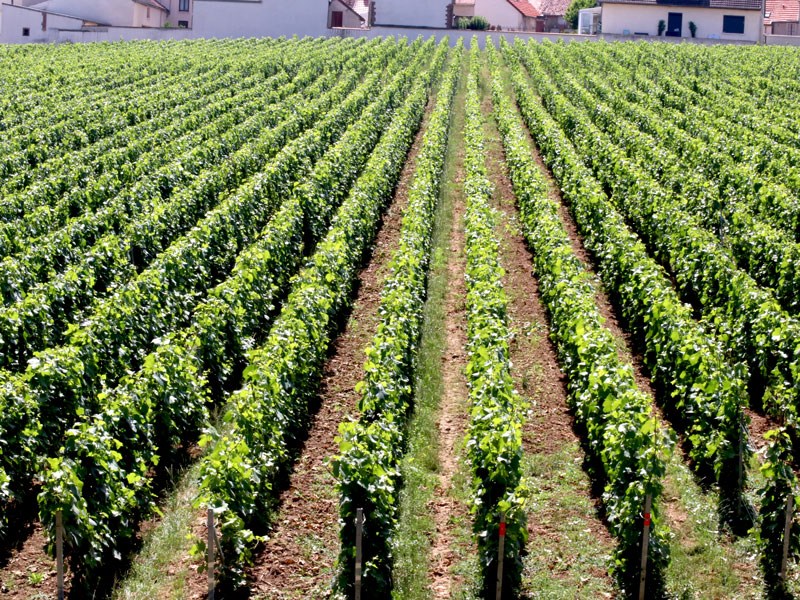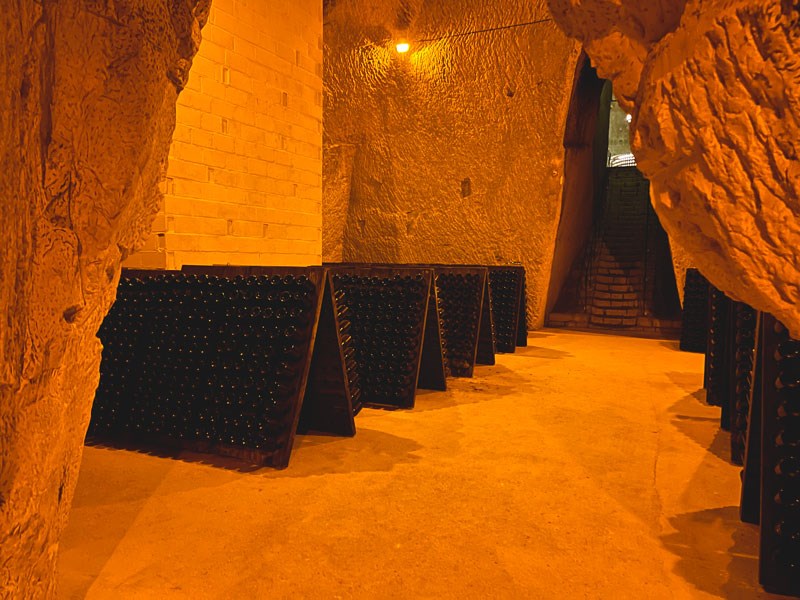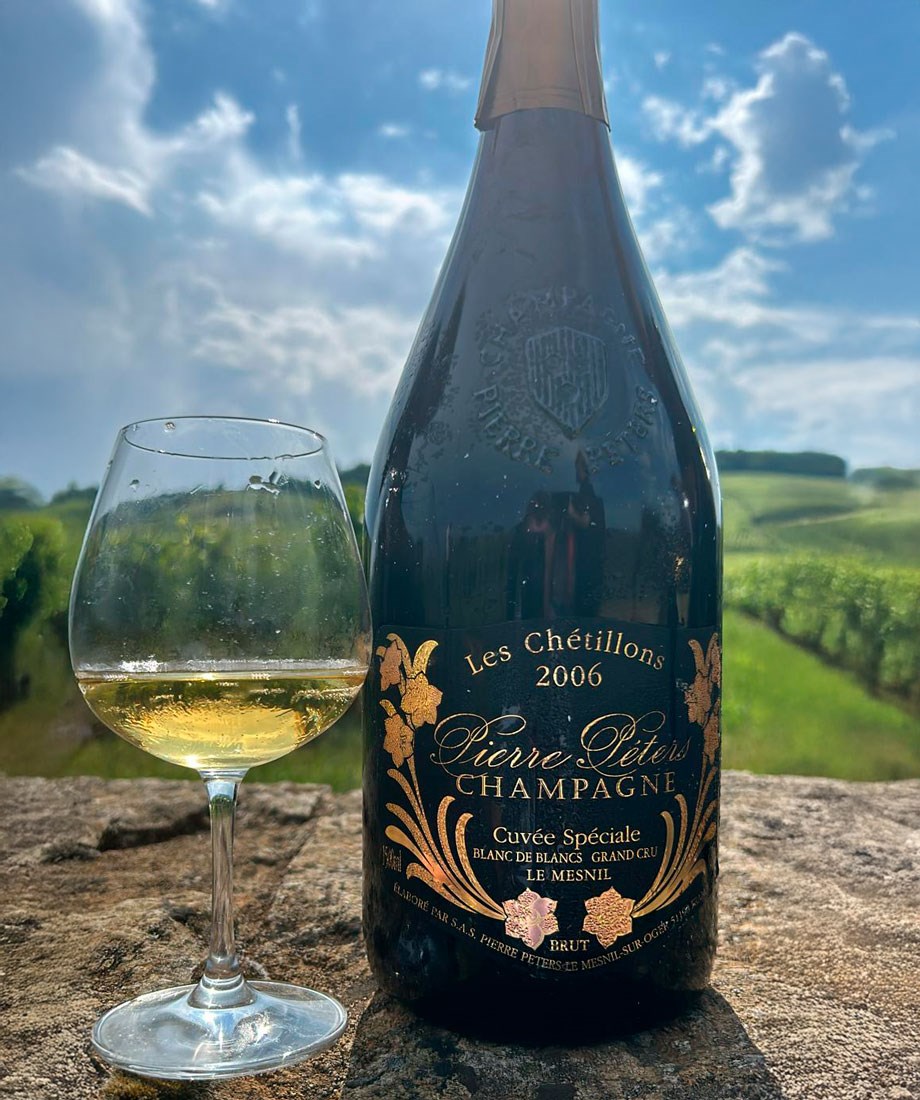Article - Champagne
From Devil's Wine to World Heritage: The Fascinating Journey of Champagne
Behind the glamour lies a long history of coincidences, discoveries, and hard work. Discover how champagne was tamed and refined.
Since 2015, the hillsides, houses, and cellars of Champagne have been listed as a UNESCO World Heritage site. "Champagne" is a protected title, meaning it can only be used for sparkling wines that meet specific requirements and come from the Champagne region in northeastern France. When you drink champagne, you are tasting a piece of culture – a product of deep-rooted tradition found nowhere else in the world.
It’s hard not to be struck by a sense of grandeur and fascination when exploring Champagne, tasting wines that have been refined over centuries by the region’s dedicated winemakers.
Yet, despite its modern-day associations with extravagance, celebration, and glamour, the bubbles we now cherish were once cursed and far from desirable. The story of how Champagne came to be is filled with chance, perseverance, and refinement. Dive into the tale here...
Champagne: An Introduction
Champagne holds its own exclusively protected title, but not all champagne is the same. There is a vast variety of different champagnes, each crafted from different grape blends, giving every bottle its unique character.
The difference between vintage and non-vintage
The most exclusive champagnes are labeled vintage champagne. Each year, Champagne produces around 300 million bottles, but only 5–10% of them are vintage, while the majority are classified as non-vintage. Vintage champagne is only produced in exceptionally good years when the weather has been ideal, and the grape quality is outstanding—producers themselves decide whether to declare a vintage. Additionally, a vintage champagne must be aged for a minimum of three years on the lees (resting with the dead yeast cells left after fermentation), while a non-vintage champagne only requires a minimum aging period of 15 months.
Blanc de Blancs, Blanc de Noirs, and Rosé
In Champagne, you will often encounter the terms blanc de blancs, blanc de noirs, and rosé, which refer to the champagne’s color as well as the grapes used in production.
Blanc de Blancs (literally “white from whites”) means that the champagne is made exclusively from white grapes. This typically means Chardonnay, the only permitted white grape in Champagne, which is grown on approximately 30% of the vineyards.
While Blanc de Blancs is made exclusively from white grapes and is often associated with elegance and minerality, Blanc de Noirs has a fuller profile with more fruit and depth.
Blanc de Noirs (literally “white from blacks”) means that the champagne is made exclusively from red grapes, which in Champagne are Pinot Noir and/or Pinot Meunier. Pinot Noir is grown on around 38% of the vineyards and thrives in the cool climate. It can also add a light color to rosé champagne through skin contact.
Rosé champagnes make up about 10% of total champagne production and are characterized by their pink hue and typically more fruit-forward profile compared to classic white champagne.
Rosé champagnes are made using either: The Assemblage Method (Blending Method), where white champagne (often made from Chardonnay) is blended with a small amount of red wine from Pinot Noir or Pinot Meunier, which is produced specifically for this purpose. The Saignée Method (Maceration Method), which is less common, where red grapes (Pinot Noir or Pinot Meunier) are pressed, and the juice is allowed to macerate briefly with the grape skins, giving the champagne its natural pink color.
By the way: Pinot Meunier is known for its resilience and ability to ripen well in cooler vintages. The grape adds fruitiness and softness to champagne and is particularly appreciated by modern producers.
How Champagne’s Sweetness Level is Determined
Dosage in Champagne refers to the amount of sugar added after the second fermentation to balance the flavor and determine the champagne’s sweetness level. After the yeast is removed, the winemaker adds a mixture of wine and sugar – the so-called liqueur d'expédition – which decides how dry or sweet the final champagne will be.
The driest champagnes, called Brut Nature or Zero Dosage, have little to no added sugar, usually under 3 grams per liter. Extra Brut allows up to 6 grams of sugar, while Brut (the most common category) can contain up to 12 grams per liter.
If the sugar content exceeds this level, the champagne becomes noticeably sweeter. Extra Sec (also known as Extra Dry) contains between 12 and 17 grams of sugar, while Sec (Dry) ranges from 17 to 32 grams. Even sweeter is Demi-Sec, which has between 32 and 50 grams of sugar per liter and is often paired with desserts. The sweetest category, Doux, contains over 50 grams of sugar per liter and is almost like a sparkling dessert wine.
The choice of dosage depends on both the producer’s style and the desired flavor profile, with drier champagnes often favored as aperitifs, while sweeter versions can be ideal for desserts or special occasions.
And now, it’s time for the story of how champagne became a reality.
 Krug Clos du Mesnil vineyard
Krug Clos du Mesnil vineyard
Champagne: The Art of Controlling a Devil’s Wine
The Champagne we know and love today has not always been associated with luxury, indulgence, and victory. Quite the opposite. And although the Romans had been cultivating vineyards and producing popular wines in northern Gaul (now the Champagne region) since the 1st century, it was not the bubbles that gained popularity.
The Romans, and later the monks, crafted remarkable wines in Champagne, which became widely known in the 9th century when they were served at the coronation of French kings in Reims. This royal connection made them sought after throughout France. By the 13th century, these fine wines were being exported to Spain, Italy, and England, quickly becoming a favorite in European markets. These wines, however, were completely free of bubbles.
Yet, producing these elegant, bubble-free wines in Champagne during the 13th century was not without its devilish challenges. Cold winters frequently settled over the region, causing fermentation in the wine to halt as temperatures neared freezing. When summer returned and temperatures rose, fermentation resumed, creating carbon dioxide in the wine—resulting in an unwanted fizzy texture.
This unexpected effervescence was far from desirable at the time. The buildup of pressure often caused corks to pop unexpectedly and even led to bottles exploding. This earned Champagne the nickname “le vin du diable” – the devil’s wine.
What was initially considered an accursed wine, however, gradually became seen as a curious novelty and gained increasing popularity among the French aristocracy in the 17th century, even though the monks had yet to gain control over the process.
For centuries, monks struggled with the unruly bubbles, but through science and innovation, they eventually mastered the process and refined the taste.
Many small contributions made Champagne a Reality
It is often said that Dom Pierre Pérignon was the inventor of Champagne and the one who tamed its bubbles. However, this is a truth with serious modifications – it is impossible to credit the creation of Champagne to a single individual.
Christopher Merret Discovered the Path to Fine Bubbles
Even before Dom Pierre Pérignon arrived at the Abbey of Hautvillers in 1668, English scientist Christopher Merret had, in 1662, presented the thesis that wine could be made sparkling by adding the right amounts of yeast and sugar. As both a physicist and a scientist, his theory was grounded in evidence.
By adding sugar and yeast, a secondary fermentation occurred, producing the delicate bubbles we cherish today. And in 1836, chemist Jean-Baptiste François discovered a method to accurately measure the sugar content in wine. This breakthrough was crucial in controlling the sugar levels for secondary fermentation, which creates the bubbles in Champagne.
Barbe-Nicole Clicquot Made Champagne Appealing
Another remarkable innovation was the invention of the riddling table (pupitre in French), developed in 1816 by Barbe-Nicole Clicquot, the woman behind the renowned Champagne house Veuve Clicquot.
Clicquot faced a challenge that plagued Champagne producers: the sediment left behind after fermentation in the bottles. This residue made the wine cloudy and unappealing. She devised a method to remove the sediment without losing the bubbles.
Her solution was the riddling table – a wooden rack with angled holes where bottles were placed neck-down. By rotating the bottles daily and gradually tilting them more vertically, the sediment collected in the bottle’s neck, allowing it to be frozen and expelled under pressure – leaving behind a beautifully clear Champagne.
Read more: 12 Prominent Women in the Wine Industry | Pioneering, Successful, and Significant
Louis Pasteur Gained Control Over Fermentation
Louis Pasteur (1822–1895) was one of history’s most influential scientists. His work revolutionized microbiology and directly improved public health and industrial processes, including winemaking and Champagne production.
Pasteur proved that fermentation was caused by living microorganisms (yeast) and demonstrated that unwanted bacteria could contaminate the process – a critical discovery for wine and Champagne producers. His research helped stabilize Champagne production by identifying how to control fermentation and prevent defects like vinegar-like flavors or flat bubbles.
So no, Dom Pérignon did not invent Champagne, nor did he single-handedly tame its bubbles. Champagne, as we know it today, is the result of many small contributions over time.
 Riddling-tables at Champagne Heidsieck
Riddling-tables at Champagne Heidsieck
Champagne Dissected
The Champagne region is located in northeastern France, covering approximately 34,300 hectares of vineyards. It is divided into five primary subregions, each with unique soil compositions and microclimates that contribute to the diversity of Champagne’s flavor profiles. More than 16,000 growers manage nearly 280,000 vineyard plots, most of which are smaller than 0.5 hectares.
But before we fully dissect Champagne, it's essential to introduce l’échelle des crus (the cru scale) to understand Champagne's classification system.
L’échelle des crus: A Defunct Ranking System
The Grand Cru system in Champagne was originally introduced to classify and determine the value of grapes from different villages and vineyards based on their quality potential. It was part of l’échelle des crus, which was implemented in the early 20th century.
Villages in Champagne were ranked on a scale from 80% to 100% based on factors such as terroir, soil, climate, and historical grape quality. Only villages rated 100% received Grand Cru status. Villages rated 90-99% were designated as Premier Cru, while the rest were not given a specific cru classification.
This percentage was historically used to determine the price of grapes from different villages. Grapes from a 100% Grand Cru village could be sold at full price, whereas grapes from an 80% village were sold at a reduced price.
There are a total of 17 Grand Cru villages, including Le Mesnil-sur-Oger, Aÿ, Bouzy, and Verzenay. The vineyards within a Grand Cru village also hold Grand Cru vineyard status.
Premier Cru includes an additional 42 villages, such as Vertus and Mareuil-sur-Aÿ. Champagnes made exclusively from Grand Cru village grapes can be labeled Grand Cru, which was traditionally considered a mark of quality. However, just like the classification systems in Burgundy and Bordeaux, understanding Champagne’s cru ranking can be complex.
Take, for example, the large city of Reims, home to some of the world’s most prestigious Champagne houses, including Veuve Clicquot, Taittinger, and Pommery. Reims also boasts historical underground wine cellars (Crayères), which are UNESCO-listed. However, despite its importance, Reims does not have Grand Cru status – whereas smaller nearby villages do.
In 2003, the official l’échelle des crus system was abolished, and pricing is no longer directly linked to cru rankings.
While the historical cru system once dominated Champagne’s classification, today, it is the unique subregions that define a Champagne’s character. Let’s take a closer look at them.
The Five Subregions of Champagne
Montagne de Reims
Montagne de Reims is known for its chalky slopes, where Pinot Noir dominates. Champagnes from this area are often powerful, structured, and have great aging potential. The most prominent Grand Cru villages here include Bouzy, Ambonnay, Verzy, and Verzenay, home to renowned producers such as Krug, Henri Giraud, Larmandier-Bernier, Veuve Clicquot, Egly-Ouriet, and Bollinger.
Reims is also one of the largest cities in the region and serves as a cultural and logistical hub for the Champagne industry. It is home to some of the most iconic Champagne houses, including Taittinger, Veuve Clicquot, Ruinart, and Pommery. Many of these houses have their cellars in limestone caves, which have been designated as a UNESCO World Heritage Site.
Côte des Blancs
South of Épernay lies Côte des Blancs – a region that focuses almost exclusively on Chardonnay. It is the world’s benchmark for Blanc de Blancs Champagne, producing wines known for their elegance, finesse, and minerality. Notable producers in this region include Salon, Jacques Selosse, Delamotte, and Perrier-Jouët, sourcing from prestigious Grand Cru vineyards in Le Mesnil-sur-Oger, Avize, Cramant, and Oger – villages that inspire envy among winemakers worldwide.
Vallée de la Marne
Vallée de la Marne stretches along the Marne River and is primarily planted with Pinot Meunier, which contributes to fruity and soft characteristics in Champagne. This region is home to key villages such as Aÿ, Épernay, Hautvillers, and Mareuil-sur-Aÿ. Some of the most prestigious Champagne houses, including Billecart-Salmon, Moët & Chandon, Deutz, Laurent-Perrier, and Philipponnat, craft their exceptional wines here.
Côte de Sézanne
Côte de Sézanne, located southwest of the more famous Côte des Blancs, is a lesser-known but significant subregion of Champagne. Its soil and climate closely resemble those of Côte des Blancs but with subtle nuances that make it unique. Named after its largest town, Sézanne, this region is home to remarkable producers such as Ulysse Collin, Jacques Lassaigne, Maison Lecomte Père et Fils, and Champagne Gimonnet-Oger.
Côte des Bar
Finally, we have Côte des Bar, a southern subregion of Champagne that stands out for its warmer climate and soil rich in clay and limestone. Closer to Burgundy, this area has been gaining recognition for its distinctive, terroir-driven Champagnes, with a growing number of small grower-producers.
The key towns in Côte des Bar include Les Riceys, Bar-sur-Seine, Bar-sur-Aube, and Urville. The region’s most renowned producers – Drappier, Marie-Courtin, Cédric Bouchard, and Vouette & Sorbée – set the standard for quality and terroir expression. Additionally, many small, innovative grower-producers continue to showcase the unique character of Côte des Bar, offering a fresh alternative to the more established Champagne houses in the north.
 Pierre Péters Champagne
Pierre Péters Champagne
A Grower-Producer: What is it?
A grower Champagne (Récoltant Manipulant) is a Champagne produced by the winemaker themselves, who both grows their own grapes and makes the wine on their estate. In contrast to large Champagne houses that purchase grapes from many different vineyards, grower-producers have full control over the entire process. This often results in more terroir-driven and characterful Champagnes, with many working with organic or biodynamic methods, similar to what we increasingly see in Burgundy.
Some of the most respected grower-producers include Jacques Selosse, known for his intense, oak-aged Champagnes, Pierre Péters, who specializes in elegant Blanc de Blancs, and Egly-Ouriet, who creates powerful wines from old vines. Bérêche & Fils focuses on traditional methods and biodynamics, while Ulysse Collin has become one of the most sought-after producers with his intense single-vineyard Champagnes.
Grower Champagnes have become increasingly popular for their authenticity and unique expression of the Champagne region’s terroir.
The Devil’s Wine Has Been Tamed, But What’s Next?
Champagne has truly established itself as the world’s most exclusive wine. But that doesn’t mean there isn’t still development and refinement happening in the heart of the bubbles.
Sustainability, biodynamics, and organic practices have come into focus, with more and more Champagne producers working towards environmental certifications such as Haute Valeur Environnementale (HVE) and Viticulture Durable en Champagne (VDC). These certifications demonstrate that producers are reducing their environmental impact and adopting more sustainable practices.
There is also growing emphasis on single-vineyard Champagnes, which highlight the unique characteristics of each vineyard (similar to what we see in Burgundy). Experimentation with unconventional grape varieties, new techniques, and earlier harvests is underway to adapt to climate change.
Champagne is no longer reserved for the nobility. Today, Champagne is rightfully promoted as a versatile wine that pairs well with all kinds of cuisine, not just festive occasions. Producers are focusing on telling the story of heritage, terroir, and craftsmanship – precisely to convey the fantastic tale of Champagne.
